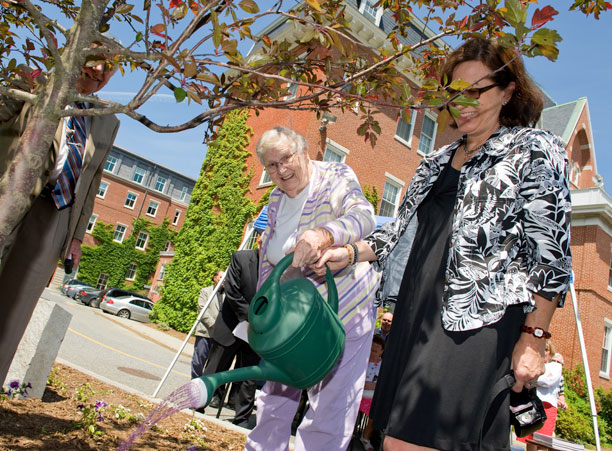To honor one of the first supporters of Holy Cross, the College recently celebrated a new tree planting on the hill beside Smith Hall and adjacent to the Jesuit cemetery.
A gathering in June paid homage to Tobias F. Boland (1795–1883), an Irish immigrant who made his reputation as a reliable leader able to recruit, train and keep construction workers needed for the heavy projects in the 1820s and ’30s: construction of the Blackstone Canal and the Boston and Worcester Railroad in 1831. When Rev. James Fitton, S.J., pastor of the Irish immigrants in the Worcester area, purchased 52 acres on a hill to create a small school for boys in 1836, Boland stepped in with contributions to include a wooden cottage to serve as a rectory for the priests who would be the academy’s instructors.
A few years later, when Bishop Fenwick visited the property and began the process of founding the College of the Holy Cross, he turned to trusted friend of the diocese Boland to build the first stone structure on campus, Fenwick Hall. Boland came to the aid of the College again after the devastating fire of 1852.
Boland’s great-granddaughter, Margaret Boland, and Thomas L. Rooney (who were both in attendance at the planting), wrote “The Irish Pioneer” (Magnolia Mansions Press, 2009), a historical novel about Tobias Boland’s adventures in family and professional life, including his vital contributions to the founding of Holy Cross.
“It was a pleasure for me to participate in the event and to meet members of the Boland family, descended through time,” says Rev. Anthony J. Kuzniewski, S.J., professor of history and author of “Thy Honored Name, A History of the College of the Holy Cross, 1843-1994” (The Catholic University of America Press, 1999). “The dedication provided an opportunity to acquaint those present with an entry from the diary James Healy kept during his senior year at Holy Cross, 1848-49.” (Healy was the College’s first valedictorian, and the son of a slave.)
“Healy’s sisters had been sent north from Georgia for schooling and boarded in Boston with Tobias Boland and his wife, who was the sister of Bishop Fitzpatrick,” Fr. Kuzniewski shares, then noting an entry from Christmas Day, 1848. “There was church, visits with family and friends and a joyful family evening with the bishop present, when the younger members of the family took turns trying to break a suspended bag of candy amid great merriment. Healy ends the entry with the observation that he had been ‘very negligent in my [religious] devotions this day.’ ”
The Boland-Ellis Memorial Tree itself is a Royal Raindrops Crabapple, which will grow to about 20 feet high and a spread of 15 feet. It is a unique ornamental addition to the Holy Cross arboretum, which already contains a wide variety of plantings. Through the hot summer months, the Royal Raindrops Crabapple will keep glossy deep purple leaves that turn orange, bronze and lighter purple in the fall. Winter wildlife will discover the tiny crimson berries that linger through the snow season. In the spring, deep hot pink blooms cover the branches.
“I am delighted that the tree and plaque dedicated to Tobias F. Boland are situated in close proximity to the Jesuit Cemetery where Bishop Benedict Joseph Fenwick, the second bishop of Boston, is buried,” says Rev. Paul F. Harman, S.J., special assistant to the president. “Tobias Boland worked on many projects for the Bishop and very much shared the Bishop’s joy in the founding of the College of the Holy Cross — named after the Bishop’s cathedral in Boston — in Worcester.”
Read an excerpt of “The Irish Pioneer” on the Holy Cross Magazine website >>
Photography by Dan Vaillancourt
[gallery orderby="title"]
Generous Benefactor and Contractor of College’s First Two Buildings Honored
Tree dedicated to Tobias Boland
Read Time
3 Minutes

